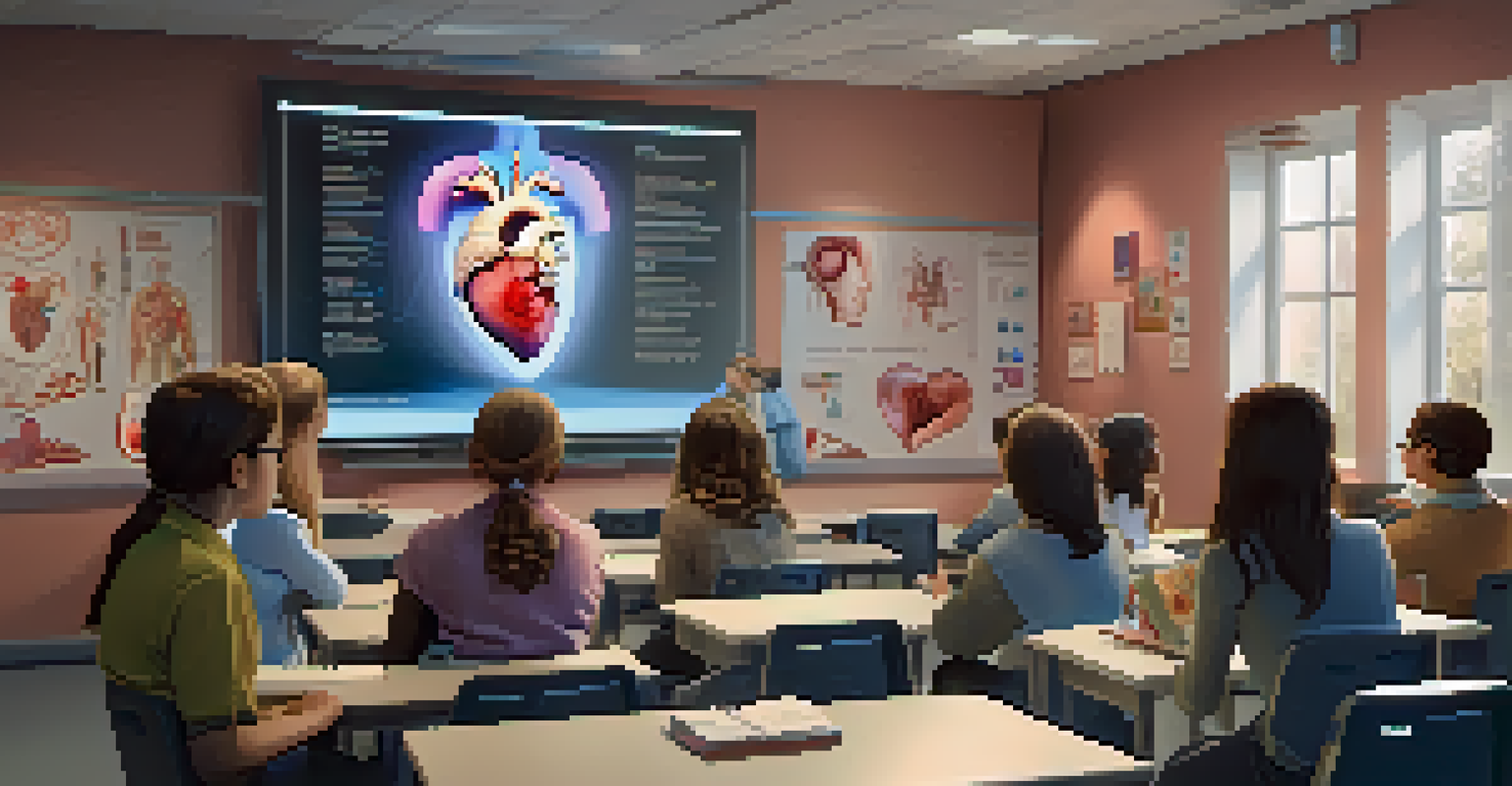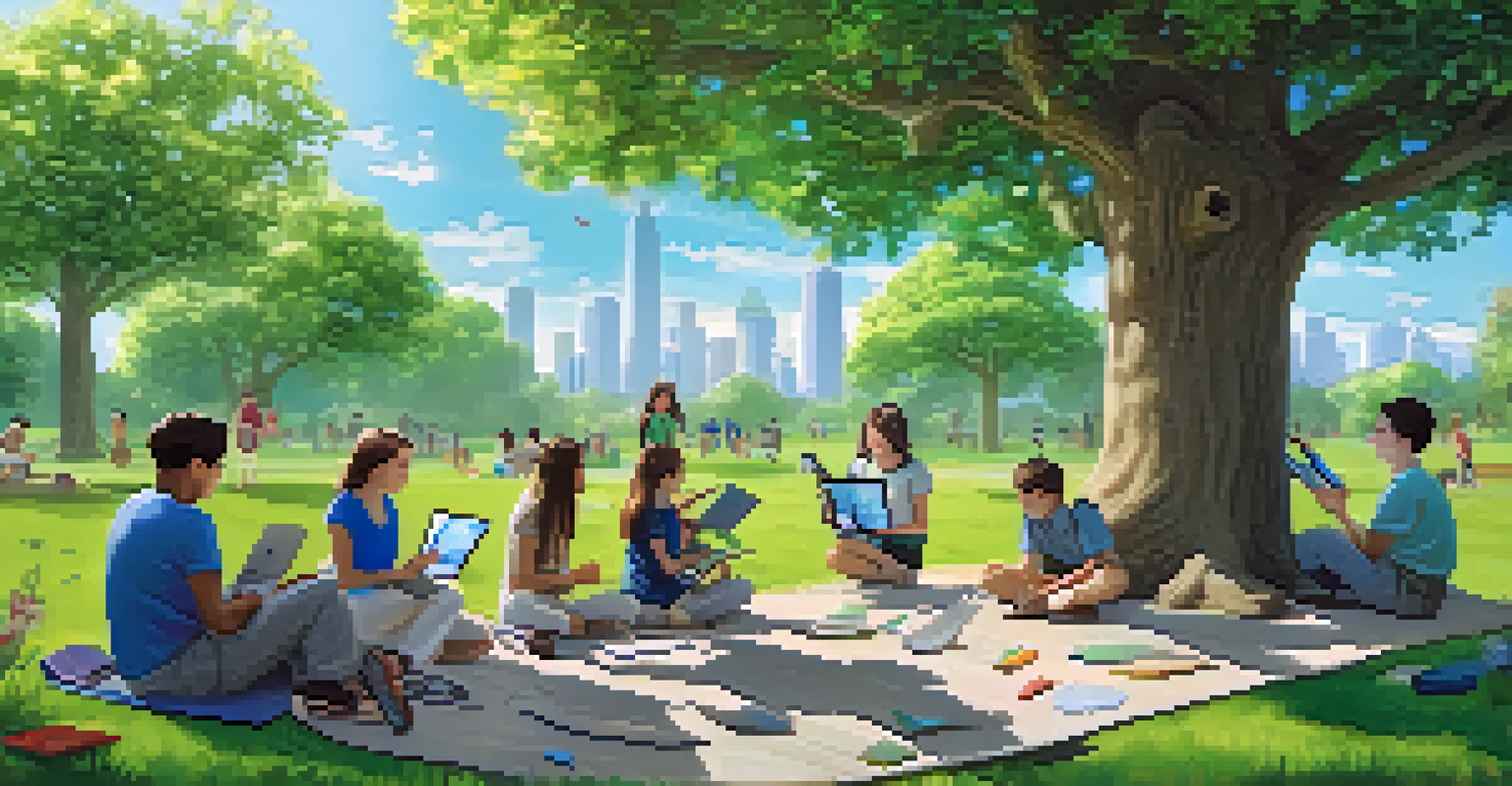The Evolution of Learning: AR as a Transformative Tool

Understanding Augmented Reality in Education
Augmented Reality (AR) blends digital information with the real world, creating interactive experiences. Imagine looking at a textbook and seeing a 3D model of the solar system pop up right in front of you. This technology allows students to engage with content in a way that traditional learning methods simply can't match. By enhancing the learning environment, AR encourages exploration and curiosity, making education more dynamic and enjoyable.
Education is not the filling of a pail, but the lighting of a fire.
In a standard classroom setting, students often find it hard to visualize complex concepts. However, AR can turn abstract ideas into tangible experiences. For instance, when studying anatomy, students can use AR to see human organs in 3D, allowing them to understand not just how they look, but how they function together. This hands-on approach fosters deeper comprehension and retention of knowledge.
Moreover, AR is not limited to just one subject. From history to science, it can enhance virtually any curriculum. By integrating AR into various subjects, educators can cater to different learning styles and create a more inclusive environment. This versatility makes AR a powerful tool in helping students succeed academically.
The Rise of AR Tools in Classrooms
Over the past few years, the market for AR educational tools has grown significantly. Companies are developing apps and platforms that make it easier for teachers to incorporate AR into their lessons. For example, programs like Google Expeditions allow educators to take students on virtual field trips, bringing history and science to life right in the classroom. This accessibility empowers teachers to create engaging lessons that captivate students' attention.

Teachers are increasingly recognizing the value of AR in enhancing student engagement and motivation. With interactive elements, lessons can transform from passive learning experiences into exciting adventures. This shift not only keeps students interested but also fosters collaboration among peers as they explore and learn together. The social aspect of learning is crucial, and AR can bridge gaps that traditional teaching methods often overlook.
AR Enhances Student Engagement
Augmented Reality transforms traditional learning by creating interactive experiences that capture students' attention and foster participation.
Additionally, the ease of use of many AR tools means that teachers do not need extensive training to get started. Many applications come with user-friendly interfaces that allow educators to integrate AR into existing lesson plans seamlessly. This simplicity encourages more teachers to experiment with AR, ultimately benefiting their students.
Engagement and Interactivity: Key Benefits of AR
One of the standout benefits of AR in education is its ability to boost student engagement. When students can interact with their learning materials, they are more likely to pay attention and participate in discussions. Think about it: how often do you find yourself glued to a video game or an interactive app? By leveraging the same principles, AR can draw students into their studies in a similar, compelling way.
The future of education is not about the technology itself but about how we use it to inspire and engage learners.
Moreover, AR supports experiential learning, where students learn through experience rather than rote memorization. By engaging with content physically and visually, students develop a more profound understanding of topics. For instance, a chemistry class using AR can allow students to visualize molecular structures, making the subject much more relatable and easier to grasp.
In this way, AR transforms learning into an adventure, where exploration leads to discovery. Rather than simply absorbing information, students become active participants in their education. This active involvement is crucial for developing critical thinking skills, as students learn to analyze and apply what they've discovered in real-world contexts.
Personalized Learning Experiences with AR
Personalized learning is an educational approach that tailors lessons to individual students' needs and preferences. AR technology can facilitate this by allowing learners to progress at their own pace. Imagine a student struggling with a math problem; with AR, they can access interactive tutorials that guide them step-by-step, catering to their unique learning speed.
Additionally, AR can adapt to various learning styles, whether visual, auditory, or kinesthetic. For example, a visual learner might benefit from 3D models, while an auditory learner may prefer narrated content. By providing multiple avenues for engagement, AR ensures that all students can find a way to connect with the material, further enhancing their educational experience.
Personalized Learning with AR
AR technology allows for tailored educational experiences that cater to individual learning styles, promoting confidence and a love for learning.
This level of personalization not only boosts student confidence but also encourages a love for learning. When students feel supported and understood in their learning journey, they are more likely to take risks and explore new ideas. This ultimately leads to a more enriching educational experience, where each student can thrive.
Challenges in Implementing AR in Education
While the benefits of AR in education are substantial, there are still challenges to overcome. One significant hurdle is the cost of AR technology. Schools with limited budgets may find it difficult to invest in the necessary hardware and software. This financial barrier can lead to disparities in access to innovative learning tools, creating an uneven educational playing field.
Another challenge is the need for training and support for teachers. Integrating AR into the curriculum requires educators to be comfortable with technology and willing to adapt their lesson plans. Without proper professional development, teachers may feel overwhelmed or unsure about how to effectively utilize AR. This lack of confidence can hinder the potential of AR to enhance learning.
Lastly, content availability is another concern. While many AR applications exist, not all subjects or topics are adequately covered. Educators may struggle to find high-quality AR resources that align with their curriculum. To maximize the impact of AR in education, continuous investment in developing diverse and relevant content is essential.
Future Trends: AR in Education
Looking ahead, the future of AR in education holds great promise. As technology continues to advance, we can expect AR tools to become more sophisticated and user-friendly. Innovations such as AR glasses could provide even more immersive learning experiences, allowing students to interact with their environment in real-time. This evolution will undoubtedly enhance the educational landscape.
Moreover, the integration of artificial intelligence (AI) with AR could lead to even more personalized learning experiences. By analyzing student performance and preferences, AI can help tailor AR content to suit individual needs, making learning even more effective. This combination could revolutionize how we approach education, creating a more adaptive and responsive system.
AR Enhances Learning Engagement
Augmented Reality transforms traditional education by making learning interactive, fostering curiosity, and increasing student participation.
Finally, as AR becomes more widely accepted in educational settings, we may see increased collaboration between educators and tech developers. By working together, these groups can ensure that AR tools meet the specific needs of teachers and students alike. This partnership is crucial for fostering an educational environment where AR can thrive and continue to evolve.
Conclusion: Embracing AR for a Brighter Learning Future
The evolution of learning through AR is not just a trend; it's a transformation in how we approach education. By enhancing engagement, personalizing learning experiences, and fostering collaboration, AR has the potential to reshape the classroom experience for future generations. As we embrace these innovations, we must also address the challenges that come with them to ensure equitable access for all students.
Educators and institutions should prioritize incorporating AR into their teaching strategies, leveraging its benefits to create more dynamic and interactive learning environments. By doing so, they can inspire curiosity and a love for learning that extends beyond the classroom. With AR, we are not just teaching students; we are preparing them for a future where technology and education go hand in hand.

In conclusion, as we stand on the brink of this exciting evolution, the possibilities for AR in education are limitless. By embracing these tools, we can create a brighter, more engaging, and inclusive future for learners everywhere. The journey has just begun, and we can't wait to see where it takes us.